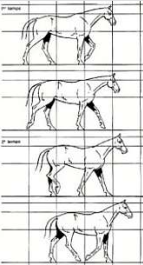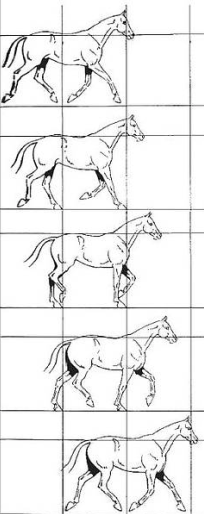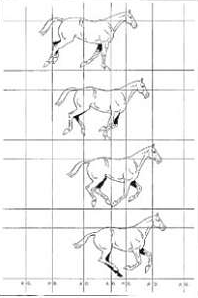The gait of the horses is a very important key factor in the analysis of races by professional bettors. We have therefore deemed it essential that in order to bet on horse racing, bettors must be fully aware of the different gaits, we distinguish between :
- the walk
- the trot
- the gallop
For horse racing, only the trot and the gallop are used.

Table of Contents
The slowest gait: the walk
The walk is the slowest gait of the horse and the most popular in the equestrian world.
This corresponds to walking for a human being. Its average speed is 7 km/h.
The walk is a walking gait, meaning that one limb is always on the ground. It is a symmetrical gait with four beats, which corresponds to the four places of the feet on the ground.
The regularity of the step is important, that is to say that the two hind legs must engage in a similar way. It is therefore understood that if one hind leg takes a long step the other should not take a short one.
The horse raises and rests its feet successively. The succession of posers is: left front, right rear, right front, left rear... and so on.


At this gait, the horse has a slight lateral sway, following the movement of the shoulders.
The rhythm of the step can be very variable, but all four beats must be equal for the step to be correct. The rhythm of the walk can deteriorate. If the horse brings the foreleg closer to the hind leg on the same side, the gait becomes sideways. This defect comes from a stiff back, or in any case from a lack of muscular harmony.
Similarly, if the horse brings the pose of the front leg closer to that of the opposite rear leg, the gait becomes diagonalized. This defect is caused by a horse that gets excited and wants to trot. It is a natural physical phenomenon, not caused by specific muscle contractions.
This is the gait most used by the horse when it is not working. With only one limb suspended at a time, this is the gait where the horse is most balanced.
The walk is used for the presentation of horses or to go to their starting line, but also for dressage or some equestrian competitions, but is not used during horse racing competitions.
The intermediate gait: the trot
The trot is an intermediate gait, it corresponds to jogging for the human being.
Its average speed is 14 km/h.
The trot is a jumped gait, symmetrical with two equal times. It is said to be jumped gait because it contains moments in which all four limbs are in the air at the same time.
The two-beat rhythm is given by the beats of the limbs, which are posed by diagonal bipeds (anterior on one side and posterior on the opposite side). The rhythm defects come from the dissociation of the diagonals, sometimes hardly visible to the eye. When one diagonal covers more ground than the other, the horse is slightly crooked. This defect is natural and can be corrected with work.

It is the whole body of the horse which is raised then lowered according to the projection and the poses of the diagonal bipeds. Hence the difficulty of the sitting trot for the jockey whose kidney must absorb the horse's movements.
The trot is the gait where the horse's back is least involved in locomotion, which makes it possible to visualize irregularities in the movement of the limbs during an examination by an expert and thus identify lameness.
The good trot includes a perfect and extended symmetry of the gesture of the 4 limbs, a good suspension at each stride, a good support of the back (the horse trots with its back). These points are to be adapted according to the speciality for which the horse is intended (dressage, competition, driving, racing, etc.).
The irregularity of the trot is always a defect not to be neglected, sign of a lack of preparation or a defect of locomotion; it can be accidental and thus without consequence once healed or be of construction which is redhibitory for any sporting use.
It is a gait widely used in the work of both horse and rider.
Fastest Gait: Gallop
The gallop is the fastest gait, it corresponds to running or sprinting for the human being.
Its average speed is 21 km/h.
The canter is a three-beat jumping gait followed by a suspension phase. It is an asymmetrical gait since there are two canters: one to the right and one to the left.
In the gallop, the poses go like this: left hind leg, left diagonal, right front leg, then comes the suspension time and the cycle starts again.

The three-beat rhythm has long been imperceptible to the human eye. There are important variations of rhythm in the gallop: collected gallop, racing gallop, etc. These variations in rhythm are often difficult to see, but sometimes easier to hear on firm ground.
Since there are two canters, the horse can change from one to the other during a canter stride: this is the change of foot. At the end of the third beat of the stride, when the horse has both hind legs up, he starts to reverse them and at the beginning of the first beat of the next stride, he finishes reversing the front legs.
In the gallop, the undulations of the spine are synchronized with the rocking movement of the horse's body. The raising and lowering of the neck accompanies these movements of the back-knee.
A good canter must be balanced with, at each stride, a good engagement of the hindquarters under the mass of the horse, a good support of the front and a good tilt of the back.
The rhythm of the pose of the limbs, the amplitude and the elasticity of the stride inform perfectly on the good functioning of the back.
The gallop is the most variable gait, as a dressage horse can gallop on the spot while a race horse can reach 60 km/h.
Conclusion :
The horse's gait (trot or canter) must be worked on daily so that it becomes automatic and performs at speed to beat the competitors. This is why a trotting horse will not race in a canter and vice versa. They are very distinct specialties.
In the next article we will look at trotting races.

Add a comment